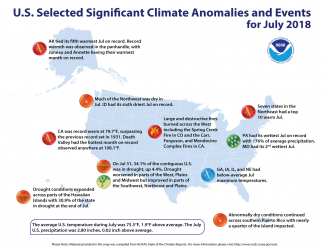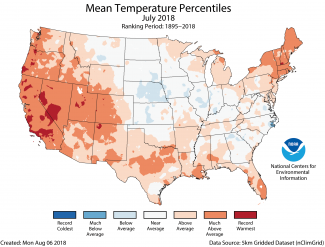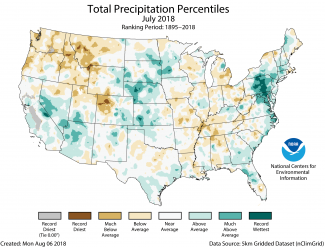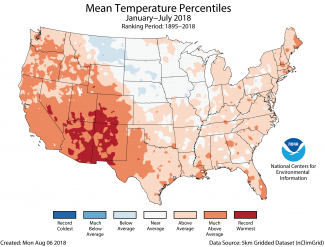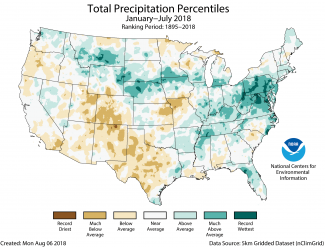The contiguous United States had its 11th warmest July on record

The July 2018 contiguous U.S. temperature was 75.5°F, 1.9°F above the 20th century average. This tied with 1998 as the 11th warmest July on record. Much-above-average temperatures stretched across the West, Northeast and parts of the South. California had its hottest July and hottest month on record at 79.7°F, surpassing the previous record set in 1931. Near- to below-average temperatures were observed across the central U.S. For the year-to-date, the national temperature was 53.1°F, 1.9°F above average, also the 11th warmest on record. Of note, the last three month-period, May through July, ranked as the warmest such period on record with a national temperature of 70.9°F, 3.4°F above average. This surpassed the previous record of 70.6°F in 1934.
The July precipitation total for the contiguous U.S. was 2.80 inches, 0.02 inch above average, and ranked near the middle value in the 124-year period of record. Above-average precipitation was observed for parts of the Southwest, East Coast and Great Plains. Record precipitation fell in parts of the mid-Atlantic where Pennsylvania had its wettest July on record with 176 percent of average precipitation. Below-average precipitation was observed in the Northwest and parts of the northern to central Rockies, Midwest and South. The year-to-date precipitation total for the Lower 48 was 18.65 inches, 0.56 inch above average, ranking near the middle value in the record.
See all July U.S. temperature and precipitation maps.
This monthly summary from NOAA’s National Centers for Environmental Information is part of the suite of climate services NOAA provides to government, business, academia and the public to support informed decision-making.
July Temperature
-
Above-average July temperatures stretched from the West Coast to the Rockies, through the South and into parts of the Northeast. Seventeen states had July temperatures that were much-above-average, including California which was record warm. The monthly average July temperature for Death Valley, California, was 108.1°F, making it the hottest monthly temperature on record for any station in the world, according to NCEI’s data holdings. This surpassed the record of 107.4°F set just last July in 2017 at Death Valley.
-
The warm and dry conditions across the West created ideal wildfire conditions. Numerous large and destructive fires burned across the region with many continuing to burn into August. These included, but were not limited to:
-
The Spring Creek Fire in Colorado burned over 108,000 acres and destroyed 251 homes. This was the third largest wildfire on record for Colorado.
-
The Carr Fire in California burned over 164,000 acres, destroyed more than 1,000 residences and was responsible for at least seven fatalities. This marks the sixth most destructive fire in terms of property loss on record for California.
-
The Ferguson Fire in California burned over 94,300 acres, was responsible for at least two fatalities and forced the closure of parts of Yosemite National Park.
-
The Mendocino Complex Fire in California burned over 283,800 acres and marked the largest wildfire on record for the state, surpassing the Thomas Fire that burned 281,000 acres in late 2017.
-
-
Near- to below-average temperatures stretched from the Great Plains into parts of the Midwest and Southeast. In the central U.S., maximum temperatures, or afternoon highs, were particularly cool during July. Above-average precipitation in parts of the region contributed to the below-average temperatures.
-
The Alaska July 2018 temperature tied with 2016 as the fifth highest since statewide records began in 1925. Parts of the Alaska Panhandle were record warm, including Juneau and Annette. Each of those locations also observed their warmest month of any month on record. Ketchikan had its second warmest July. The warm conditions contributed to a fish kill near Petersburg, Alaska.
July Precipitation
-
Above-average precipitation was observed across parts of the Southwest, Great Plains and along the East Coast. In the Southwest, an active monsoon season brought heavy thunderstorms to the region. In the East, record and near-record precipitation was observed for much of Pennsylvania and parts of Maryland. Pennsylvania had its wettest July on record with 7.37 inches of precipitation, 3.18 inches above average. Maryland had its second wettest July with 8.72 inches, 4.55 inches above average.
-
Below-average precipitation fell across much of the Northwest and in parts of the northern to central Rockies, Midwest and South. Idaho had its sixth driest July on record with just 0.24 inch of precipitation, 0.59 inch below average. Much of Alaska was also drier than average, particularly the central regions and the panhandle.
-
According to the July 31 U.S. Drought Monitor report, 34.1 percent of the contiguous U.S. was in drought, up from 29.7 percent at the beginning of July. Drought conditions worsened in the Northwest, Central Rockies, Southern Plains, mid-Mississippi Valley and Great Lakes. Drought improved in the Southwest, Northeast and parts of the Central to Northern Plains. Outside of the contiguous U.S., drought worsened for parts of Hawaii, but abnormally dry conditions improved for parts of southern Puerto Rico.
Year-to-Date (January-July) Temperature
-
Above-average January-July temperatures were observed across the West, Southern Plains, East Coast and much of the Midwest. Nine states in the West and South had much-above-average year-to-date temperatures, including Arizona and New Mexico which were record warm. The Arizona statewide average temperature was 62.7°F, 4.0°F above average, and the New Mexico temperature was 56.5°F, 3.9°F above average. Near- to below-average temperatures were observed in the north-central contiguous U.S.
-
The Alaska statewide average temperature for the year-to-date was 29.9°F, 4.0°F above average, and tied 2014 as the sixth warmest on record. Above-average temperatures were observed across western and northern areas of the state, with near-average temperatures in southern Alaska.
Year-to-Date (January-July) Precipitation
-
Above-average precipitation was observed in the Northern Plains, Midwest and along parts of the East Coast. Record precipitation was observed across parts of the mid-Atlantic, where Pennsylvania was record wet with 34.08 inches of precipitation, 9.01 inches above average. Six additional states in the East were also much wetter than average.
-
Below-average precipitation was observed for locations across the West and Southern to Central Plains. Colorado had its 12th driest year-to-date on record with 8.79 inches of precipitation, 2.38 inches below average.

